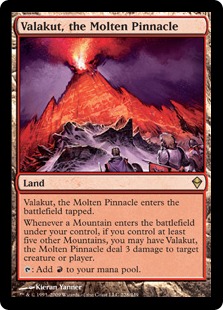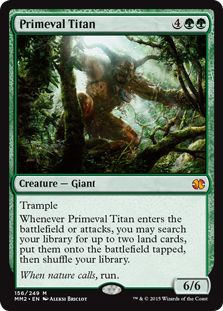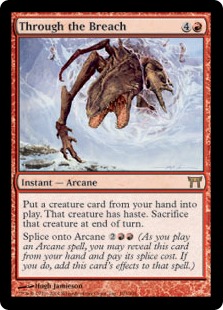Are you a Quiet Speculation member?
If not, now is a perfect time to join up! Our powerful tools, breaking-news analysis, and exclusive Discord channel will make sure you stay up to date and ahead of the curve.
Here at Deck of the Week we've focused, mostly by design, on the no-tier dregs and the brewers' oddities. Today I wanted to highlight a deck that, having fallen from its Tier 2 showing in May, has nonetheless still been making the rounds in competitive play. The deck I'm calling RG Valakut looks to have some real chops in Modern. Over the last four SCG Opens it has put two people in Top 8 (Matthew Voltz and Daniel Hendrickson) and one more in Top 16 (Adam Liu). However, these high-profile finishes aren't really buttressed by a ton of lower-level showings, which helps explain its low tier. This deck may not be crushing handily but it's certainly not flash-in-the-pan either---I liken it more to something like Grixis Control or Elves which are frequently flirting with Tier 2 and may be awaiting the right metagame developments.

There seems to be little consensus on how to build a red-green Valakut deck, which I suspect is one of the things holding it back from the higher tiers. What these decks share in common is the pairing of Valakut, the Molten Pinnacle with Primeval Titan in their best impression of the classic Standard deck. Through the Breach typically makes an appearance as well. Where they differ is in the inclusion of Emrakul, the Aeons Torn, Summoning Trap, Oracle of Mul Daya/Courser of Kruphix, and Scapeshift.
[wp_ad_camp_1]
Here's Matthew Voltz's build that he took all the way to the finals in Syracuse this weekend.
RG Valakut, by Matthew Voltz (8th, SCG Open Syracuse)
Anyone familiar with Modern needs no introduction to the card Valakut, as its typical bedfellow Scapeshift has been a long-time Tier 2 staple of the format. Where Scapeshift tends towards the control spectrum, buying time with countermagic or accessing a toolbox via Bring to Light, the red-green versions are true combo decks. They've been reported under a myriad of different names, from Titan Shift, to Through the Breach, to Summoning Trap, to Scapeshift, but each of these builds works along a fundamentally similar strategic axis.
Why Red-Green?
At first glance Primeval Titan might seem merely like a weaker Scapeshift. If your goal is to one-shot opponents from nowhere, then it's hard to argue with that assessment.  But where RG Valakut excels in comparison to its bluer cousin is in setting up for a near-interactionless kill several turns later, of which Titan is an instrumental part.
But where RG Valakut excels in comparison to its bluer cousin is in setting up for a near-interactionless kill several turns later, of which Titan is an instrumental part.
To understand why this deck plays so differently from Temur versions of Scapeshift, the first place you have to look is the mana base. With 12 Mountains and an additional 8 fetches to find them, once you've set up an active Valakut virtually every land drop becomes a Lightning Bolt (or better). In contrast, the Scapeshift deck I played at the SCG Milwaukee Open ran only 9 Mountains and 4 fetches. It wasn't uncommon to run out of Mountains in the mid- to late-game, and there were plenty of Flooded Groves and Islands to top-deck when I was praying for that last Bolt. My build tried to address this with Prismatic Omen, but that doesn't come for free. It's another spell that has to resolve, can be interacted with, and sits helpless on the table ready for a timely Nature's Claim.
RG Valakut, on the other hand, is a terrifying well-oiled machine as soon as it hits that seventh land. Besides the Valakuts themselves, only two lands in the whole deck (basic Forests) fail to trigger it. So while the first Primeval Titan may hit for a less-than-lethal number before getting pathed, the opponent is left staring down a lethal mana base---notoriously hard to combat using typical answers found in Magic.  At this point, every Farseek and Sakura-Tribe Elder becomes 3-6 damage. And those are the set-up spells---the Valakut pilot is still drawing to actual business spells too. Scapeshift can accomplish this mono-business-in-library trick using Prismatic Omen, but as I've said above there are costs associated with that and it's answerable. RG Valakut accomplishes this largely in deck construction itself.
At this point, every Farseek and Sakura-Tribe Elder becomes 3-6 damage. And those are the set-up spells---the Valakut pilot is still drawing to actual business spells too. Scapeshift can accomplish this mono-business-in-library trick using Prismatic Omen, but as I've said above there are costs associated with that and it's answerable. RG Valakut accomplishes this largely in deck construction itself.
The other advantage these builds of Valakut have over the more popular Temur and Bring to Light versions are just their speed. They trade off interaction and flexibility for balls-to-the-wall fast kills and consistency. These decks are going to execute their plan the same way more or less every time barring disruption, and there are a lot of redundant parts. When your whole mana base is Mountains, setting up Valakut is relatively trivial, and resolving a Primeval Titan won't be strictly necessary in every game.
Of course when you do resolve it, and assuming it lives one turn to attack (or comes in off a Through the Breach) that's a quadruple Rampant Growth attached to a six-point hit to the face. While the first Titan hit usually isn't lethal by itself, it will be rare to see a second one that doesn't get the job done.
Bells, Whistles, and Supplemental Plans
Through the Breach allows for some tricky plays against controlling decks, where you can test the waters end step with a Breach. If that gets countered you can untap and slam Titan. Cheeky Valakut players have also been known to cast the "bluffed" Breach---if they know an opponent can't afford to let it resolve they might finesse a counterspell  out of their hand even when they had nothing to cheat into play. Traditionally, the Breach plan was augmented with Emrakul, the Aeons Torn for another win-on-the-spot button, which we see in Voltz's build above. He makes use of another old piece of tech, Summoning Trap, to provide more avenues for putting his expensive monsters on the battlefield.
out of their hand even when they had nothing to cheat into play. Traditionally, the Breach plan was augmented with Emrakul, the Aeons Torn for another win-on-the-spot button, which we see in Voltz's build above. He makes use of another old piece of tech, Summoning Trap, to provide more avenues for putting his expensive monsters on the battlefield.
Other builds of RG Valakut elect instead to augment Prime Time with anywhere from one to four copies of Scapeshift, or rely entirely on Titan and land drops as win conditions. Alternately we see Oath of Nissa to dig for threats, a variety of midrange threats like Pia and Kiran Nalaar or Obstinate Baloth, the inclusion or omission of Prismatic Omen, different selections in ramp spells, etc.
Overall this extensive variation points to an underdeveloped archetype. There doesn't seem to be a strong consensus on what the best build is which, together with the relatively small number of pilots, may be hurting the archetype's chances at climbing the tiers. I for one would love to see the archetype in the hands of more players; there appears to be some opportunity here to tune a deck that's still largely misunderstood by much of the Modern playerbase.




Nice article, and especially poignant given that Matthew Voltz reached the final at the SCG Open. I think that the version of the deck that splashes white and sports Nahiri, the Harbinger as an additional “cheat large creatures into play with haste” win condition is the one I’d wager is the strongest right now (especially given the access to Path to Exile to deal with threats Bolts and Angers cannot), but given how underdeveloped this archetype is, that’s obviously up for some debate.
Ah, I completely forgot about the Naya version! Nahiri is actually showing up in a good number of lists (mostly online iirc), so you’re certainly not the only player thinking that way.
Couldn’t agree more. This deck is way too good to be played as little as it is. This used to be my pet deck and I worked my fingers to the bone to create a list that was as balanced as could be, without giving up too much consistency on the combo part of the deck.
http://tappedout.net/mtg-decks/deathmetal-breach/
For me, the biggest problem was making the deck not auto-lose vs burn/affinity/infect unless you had t3 breach. That list was tuned for a GP last year when Twin was still legal, so I would probably not play 4 skites in the SB. But it was the only way I could think of to shore up some bad MU’s at that time. Burn/Infect was a big problem back then. Tarmogoyf was a late addition to the deck after I tried to figure out how to fix my early game against aggressive decks while making Trap better and having an early threat or defender. It was amazing and I’m surprised that I never saw it in any other build. People seems obsessed with overloading the deck on big win conditions. Another card that people don’t understand is Summoning Trap. On the Open stream Hunt was talking about how it’s gonna cost R/G Breach to have it in the deck vs Jund etc, as if the only mode on the card is to cast it for 0. Casting it for 6 mana still makes a Titan or an Emrakul most of the time.
I’ve tried basically every build there is, and could go into GREAT length on why Scapeshift is worse than Trap in this deck and should be a one of at the most, but if you excuse me I have to go and buy the deck back!
I like ramp…I like combo…I genuinely want to make this deck now. Awesome!